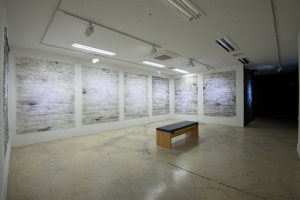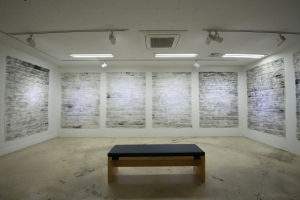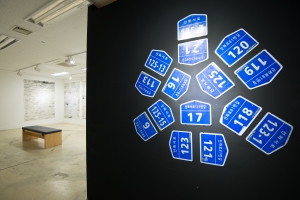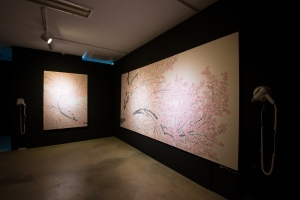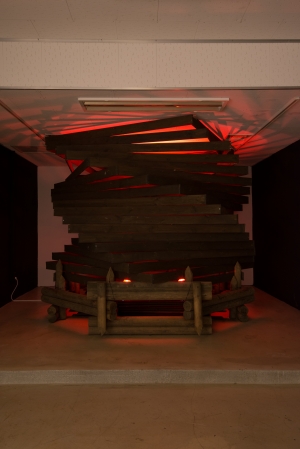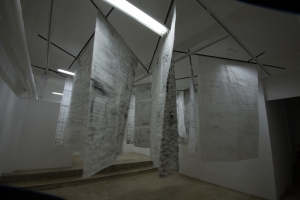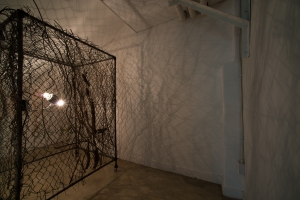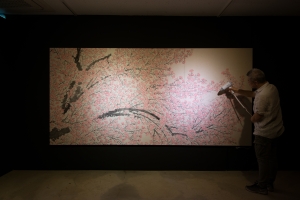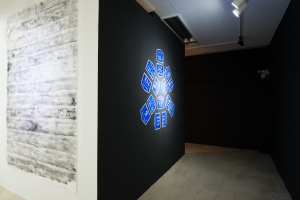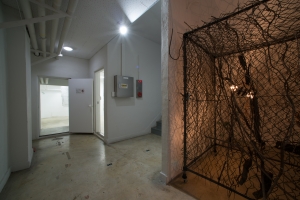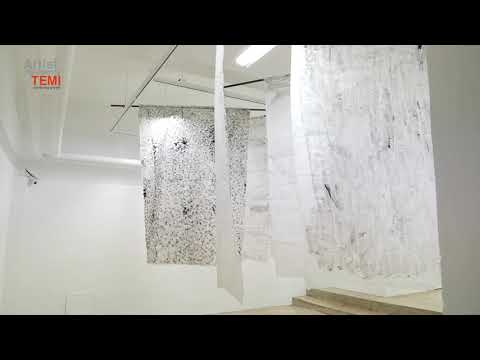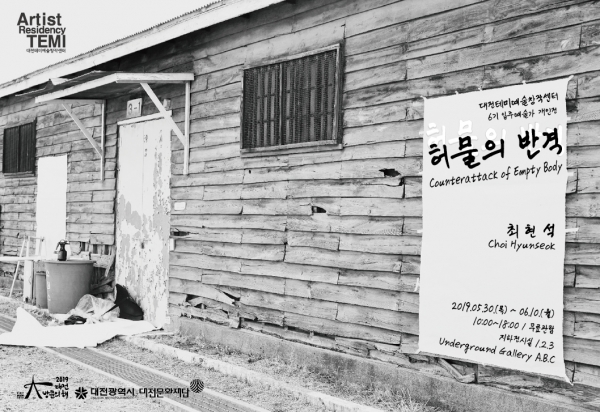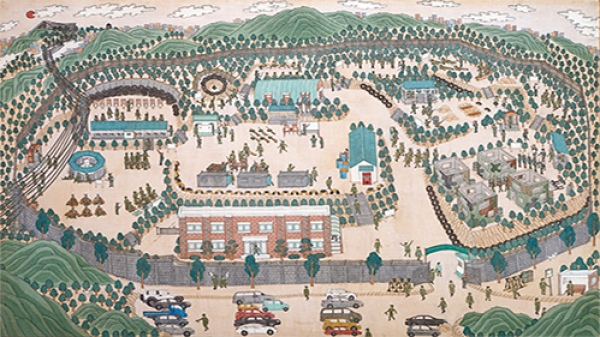전시 EXHIBITION
허물의 반격 Counterattack of Empty Body
금자탑도 언젠가는 무너지게 되어있다. 온갖 애정으로 공들이며 차곡차곡 높이 쌓아 올렸을수록 무너질 때 오는 허탈함과 상실감은 투자한 시간만큼 이루 말할 수 없이 더욱 상황을 황폐하게 만들어버린다. 지금 어디선가에는 어느 누군가가 쌓아올린 금자탑 또한 또 다른 금자탑을 쌓고자하는 이들에 의해 여태까지의 공들임은 송두리째 무너지고 있을지도 모른다. 신이 아닌 이상 살아있는 모든 생명체들은 이 세상에 태어난 이상 언젠가는 죽음을 맞이한다는 것을 우리들은 이미 잘 알고 있다. 즉, 누군가는 시간을 거스른 척 할 순 있지만 실제로 완벽하게 거스른 이는 한명도 없다. 하지만 영원히 살 것처럼 열정적으로 행동하지 않으면 세상에서 마주한 모든 것들은 시작도하기전에 벌써부터 삶이 무의미해져 버린다. 그래서 언젠가는 죽는다는 것을 이미 앎에도 불구하고 어떠한 행동이나 열정을 보인다는 것은 아직까지 살아있다는 증거이자 노력에 의해 남아있는 시간과 죽음의 그림자를 잠시나마 조금이라도 뒤로 유보시킬 수 있는 아주 작은 가능성에 대한 몸부림일지도 모른다.
평소에 해왔던 기존의 기록화 작업은 숲을 어떻게 하면 고스란히 한 화폭에 녹아낼 수 있을지에 대한 고민이 주를 이루었다면 이번 개인전은 숲을 구성하는 나무들을 직접 하나하나 만져가며 느껴 봐야했던 탐사적인 흔적들이라 볼 수 있다. 세상에 영원한 것은 없다는 듯 대전구도심 또한 무언가 변화를 꿈꾸고 있는 듯이 쿵캉쿵캉~ 쿵쿵~ 주변 환경개선을 목적으로 실시하던 공사소리가 작업실 주변을 몇 달 동안 맴돌고선 더 나아가 구도심 곳곳에서도 종종 무언가 자리하고 있었던 것들이 한순간 사라져가는 현장들을 쉽게 목격하게 되면서 당시의 소멸되고 있던 피사체의 잔상들이 무언가 생존 혹은 삶에 대한 메시지를 말해주고 있는듯 머릿속을 헤집어 놓아 이번 개인전 재료로 당시 무언가 느꼈던 요소들을 적극 활용하여 그에 대한 물음의 결과가 어떻게 나올지 한번 확인해보면 어떨까란 막연한 생각을 하게 되었다. 그리하여 주변 곳곳에서 발견한 사라지거나 소실될 운명에 놓인 피사체들과 조만간 사라질 것을 알면서도 사람들 마음을 홀리려는 피사체 그리고 끊임없이 살아 남기위해 변종을 꿈꾸는 피사체 등 여러모로 주변에서 발견한 버려지고 앞으로 없어질 일만 남은 생명력을 잃고 방치된 피사체들을 전시를 이루는 재료들로 적극 활용하여 이젠 폐기물이 될 운명만 남은 쓸모없음이란 답안에서 전시라는 가치의 힘을 잠시나마 활용하여 우리가 마주한 삶 혹은 생존에 대한 생각을 나름 진지하게 고민해 볼 수 있는 쓸모의 장이 이번에 준비한 개인전을 통해 조금이나마 느껴 질 수 있기를 기대한다.
-
허물, 세속화에 대한 관심
류철하(이응노미술관장)
최현석의 <허물의 반격>은 포크레인의 굴착소리로 가득한 구도심의 흔적을 따라, 사라져가고 소멸된 과거를 상기하고, 대책 없는 도시재생에 대한 은유로 허물이 반격해 온다는 설정으로 전개된다. 그러나 허물, 표면, 껍질, 등 도시재생으로 방치된 건축물의 잔해와 형체라는 표면은 그 누구도 아닌 작가 자신의 시선이고 그것이 반격하여 돌아오는 대상도 작가이다. 허물이라는 표면에 대한 사고는 작가 자신의 반성적이고 상징적인 관심에서 비롯된 하나의 유머라고 생각하면 된다. 보통 유머는 두 가지 상황의 모순된 것에서 유래하는 심리적인 해소양식인데 최현석은 이러한 것을 자신의 작품에 적절하게 활용하여 왔고 현실주제에 대한 전복을 회화에 구사하면서 관습이 가지는 다양한 요소에 대해 비판해 왔다. 이 유머는 현실의 딜레마를 포함하는 단어와 소재선택, 일상적이고 세속적인 비유라는 측면에서 매우 유희적이다.
예를 들면 이렇다. 작품 <졸가리>는 테미공원에서 버려진 철망폐기물을 작품화 한 것이다.
테미공원의 보호막 역할을 잘 해주었다가 이제는 한 몸이 되어버린 낡은 나뭇가지 즉 졸가리들을 품고 있다. 졸가리의 정의는 “잎이 다 떨어진 나뭇가지”이고 다른 의미로는 군더더기 뗀 남겨진 글자, 곧 핵심을 뜻한다. 시민편의를 위해 급조되고 버려진 졸가리를 통해 현실의 단면을 풍자하고 있다. 졸가리가 졸가리 없는 것으로 나타났다 사라진다.
나타났다 사라지는 풍경은 봄날의 환상과도 같은 벚꽃에도 있다. <환상화>는 온도에 따라 변색하는 시온안료를 사용하여 생겨났다 사라지는 벚꽃을 신기루처럼 표현해 내었다. 벚꽃의 만발과 사라짐, 이 아름다운 풍경 앞에 참으로 졸가리 없는 삶이 자리한다. 삶의 역사가 빗겨난 껍질같은 사물들이, 버려진 그리고 재생이라는 이름의 아이러니에 환영을 부여한다.
최현석은 껍질에 주목하는 삶, 표면의 힘에 관심을 가진다. 곧 세속화와 그것이 작동되는 방식에 대한 주목이다. 빈몸, 껍질, 쓰임을 다한 사물들, 혹은 재생을 위해 남겨진 몸들은 허물 그 자체로 말하여 온다.
최현석은 “소멸되고 있던 피사체의 잔상들이 무언가 생존, 혹은 삶에 대한 메시지를 말해주고 있다”고 말한다. 테미창작센터 주변 혹은 재개발이 진행되는 도시의 곳곳, 가령 소제동이나 목동, 선화동 등지에서 그토록 허망하고 갑작스럽게 사라지는 건축물들과 사물들이 이제는 그 껍질이나마 자신의 존재와 기억을 증거하고 있다는 것, 곧 망각의 풍경을 보여준다고 말한다.
최현석은 선물 받은 공기정화식물의 죽은 풍경을 오브제 설치로 만들었다. 보호하지 못하는 자신, 공간, 이것에 대한 은유를 담고 있다. 새로운 것은 탄생시키는 작업실이지만 정작 자신은 한 생명도 돌보지 못한다. 풍경의 실체에서 비껴난 비주류의 삶 그것이 자신의 삶이다. 이러한 비주류는 곳곳에 있고 또한 주소불명이다, 재개발지역에서 수집한 주소표찰은 이제는 갈 수 없는 유령주소들이다. <유령꽃>은 급조되어 진행되는 재개발에 대한 비판을 담고 있다.
<병풍>은 병든 풍경이기도 하고 병든 바람이기도 하다. 병든 바람은 바람을 막는 병풍이 되지 못하는 허약한, 그리고 쇠퇴하고 낡은 한 풍경을 지칭한다. 대전역 동광장 주차장에 있는 오래된 목조창고는 철도보급창고 3호 건물로 근대문화유산이다. 최현석은 마르고 뒤틀린 목조표면의 다양한 질감을 탁본으로 떠서 삼면의 풍경화로 감상할 수 있게 설치하였다. 최현석은 그것을 ‘병든 풍경’이라 말하고 낡은 목조건물의 껍질에서 사그라져가는 근대의 한 장면을 병치시켰다. 무늬, 색깔, 형태, 형식, 흔적은 아름답고 덧없는 풍경으로 사라진다. 병든 풍경은 아련한 기억 저편에 가 닿아 있다.
최현석은 또한 근대의 풍경이 아닌 현실의 풍경을 안내한다. <피상의 숲>은 재개발 곳곳에서 탁본한 다양한 물성이 바람에 날리는 풍경을 연출하였다. 개별의 껍질은 어느새 전체이면서 하나의 이미지가 되어 피상의 숲에서 날린다. 피상의 숲을 거닐며 삶을 장식했던 무늬들과 껍질들이 얼마나 황홀하였던가를 반추한다. 때론 형식이 우리 삶의 전부였던 때가 있었다.
자 그리하여 이제 우리의 작가는 이러한 피상, 껍질, 그리고 삶의 무늬를 이루었던 흔적에 대한 기념비를 만든다. 바로 <금자탑>이다. 작가에게 금자탑은 위대한 역사나 업적이 아니고 일상 자체이다. 금자탑은 멀리 있지 않다. 테미공원 주변 환경정비공사로 버려진 방부폐기목을 최대한 그럴 듯하게 쌓아놓고 금자탑이라 명명하였다. 작가는 금자탑을 “어떤 형태라 설명하기 쉽지 않은 무형에 가까운 거대한 조형물”이라 설명한다. 완성된 형식과 의도, 그리고 언젠가 무너질 위대함을 작가는 무형의 조형의지로 바꿔 놓고자 한다. 그러나 무형에 가까운 조형물은 나선형의 비틀린 사각구조물, 유전자 정보체계나 고분의 천문우주구성 방식과 유사하다. 금자탑의 조형 축적방식은 고대 고분에 나오는 우물천정(말각조정방식), 곧 우주와 하늘, 은하수를 상징하는 형식과 닮아있다. 테미공원이 상수도 집수시설이었던 것 생각하면 작가의 상상력은 그럴듯하게 이해되기도 한다. 폐기될 운명의 “쓸모없음”이 사실은 “쓸모있음”이고 금자탑이며 “졸가리”이고 “주류”고 “실상”이며 아무것도 아닌 것이 아니라는 것, 그것에 대한 가벼운 유머가 최현석이 말하고자 하는 의도일 것이다.
비루한 삶에, 껍질에, 무늬들에 의미를 새겨주는 것, 은유로 이루어진 하나의 형식을 기억하게 하는 것, 당신의 삶이 사실은 금자탑이었다는 것을 알게 하는 것, 이것이 작가가 말하는 허물의 반격이다.
쉽게 만들고, 부수고, 어이없이 재생해버리는 이 맥락없는 삶의 세속화가 최현석의 작업에서 표현된다. 언젠가는 나타날 사소한 허물, 껍질, 쓸모없음이 그의 작품 속에서 유희적 전복의 시도로 나타나고 있다.
Attention to Empty Body and Secularization
Ryu Cheol-ha (Chief Director, LeeUngno Museum)
Choi HyunSeok’s “Counterattack of Empty Body” follows the traces of the old downtown filled with the digging noise of excavators, recalling the vanishing and annihilated past, and presents a metaphor on irresponsible urban regeneration based on a scenario of empty bodies fighting back. However, the surfaces of the remains and shapes of buildings neglected amidst urban regeneration, such as empty bodies, facades and skins represent the viewpoint of the artist himself, who is also the target of the counterattack. His consideration of the empty body or surface may be regarded as a kind of humor originating from the artist’s reflective and symbolic interest. Usually, humor is a mode of psychological relief derived from the contradiction between two situations, which Choi has appropriately utilized in his works to criticize the various elements of customs by applying the subversion of realistic topics in painting. This kind of humor is highly playful considering the choice of words and subject matters that incorporate dilemmas in reality as well as routine and secular metaphors.
Let’s take the example of Jolgari (stripped stalk of dry bits), which was produced using wire mesh wastes found in Temi Park. It holds old twigs that used to form a protective shield for the park and have now become one with it. The definition of the Korean word jolgari is ‘twigs stripped of their leaves’ and it also means the outline free of superfluous details or the gist. He satirizes parts of reality through stripped twigs hurriedly set up for the convenience of the public and then abandoned. The stripped twigs appear without the gist and then disappear.
There’s a scene of disappearance after appearance, too, for cherry blossoms that resemble a fantasy on a spring day. Fantasy Flower recreated cherry blossoms that come out and then disappear like a mirage using thermochromic color paints that change colors according to the temperature. In the face of the beautiful scenery of full bloom and disappearance of cherry blossoms lies a life truly devoid of the gist. Objects resembling skins that the histories of lives have missed bestow illusion on the irony of the words ‘abandoned’ and ‘regeneration.’
Choi pays attention to a life focused on skins and the power of surface. It’s the attention to secularization and the way it works. Empty bodies, skins, objects whose uses are exhausted, or bodies left for regeneration, speak through the skins.
The artist says, “The afterimages of subjects in the process of elimination deliver certain messages about survival or life.” He suggests that buildings and objects that disappear so futilely and suddenly around the Artist Residency TEMI or various corners of the city where redevelopment projects are going on, such as Soje-dong, Mok-dong and Seonhwa-dong, show the scenery of oblivion, or the fact that at least their skins bear evidence to their existences and memories.
Choi created object installation of the scene showing the death of air purifying plant which he received as a present. It carries metaphors about the artist himself who is unable to protect it, the space and the plant. He works at the studio where new things are created, but he fails to take care of a small life. His life is that of someone who belongs to a fringe group placed outside the true nature of the scenery. Those in the fringe are seen everywhere and live at unknown addresses. Address plates collected from redevelopment zones show ghost addresses that you can no longer visit. Phantom Flower embodies criticism on redevelopment projects carried out in a hurry without well thought-out plans.
Sick Wind literally means sick landscapes or sick wind in Korean. The sick wind signifies weak and old scenery in decline, which can’t play the role of a folding screen protecting against wind. There’s an age-old wooden warehouse, the Railroad Supply Warehouse No.3, in the East Square parking lot of the Daejeon Station. It is a modern cultural heritage. Choi made rubbings of the dry and twisted wooden surfaces of the structure, showing different textures, and installed them as landscapes on three walls. Calling them ‘sick landscapes,’ the artist placed, side by side, the waning scenes of the modern age from the skins of the old wooden building. The patterns, colors, shapes, styles and traces vanish beyond the beautiful and transient sceneries. The sick landscapes brush against the other side of the faint memory.
In addition to the landscapes of modernity, Choi also presents landscapes of reality. In Forest of Surface, he produced a scenery in which various matters bearing rubbings from different corners of redevelopment sites flutter in the wind. Individual skins become whole and one image, before we notice, and fly in the woods of superficiality. Walking in the woods, one ruminates on how fascinating were the patterns and skins that used to decorate our lives. There were times in which forms constituted everything in our lives.
So, now our artist builds a monument on the superficiality, skins, and the traces that formed the patterns of our lives. That’s Pyramidal. For the artist, a monument does not stand for a great historical event or achievement but for daily life itself. It is not far away from us. He stacked up treated timber, abandoned due to the environment improvement works around Temi Park, with a style and named it Pyramid. Choi explains the work as a gigantic sculpture, which is almost immaterial, with a form difficult to define. He attempts to alter complete forms, purposes, and greatness that is sure to crumble down someday, with immaterial will of formation. However, the nearly immaterial sculpture is similar to twisted spiral rectangular structures, genetic information system or composition of the universe. The way the monument was built resembles coffered ceiling found in ancient tombs, which symbolizes the universe, sky and the Galaxy. Considering that Temi Park used to be a water collection facility for public water supply, the artist’s imagination makes sense in a way. The ‘uselessness’ of things destined to be discarded is actually ‘usefulness,’ ‘pyramidal,’ ‘jolgari,’ ‘mainstream,’ and ‘actuality,’ which is not ‘nothing,’ and what Choi is trying to say seems to be a light humor about it.
What conveys meanings to pitiable lives, skins and patterns; what makes us remember a form composed of metaphors; and what makes you realize that your life in fact has been a monument: This is the counterattack of empty body that the artist presents.
Choi’s works show the secularization in the life without a context, where it is easy to make, break and regenerate preposterously. Trivial flaws, skins and uselessness appear in the works in an attempt to a playful subversion.
- 기간
- 2019-05-30 ~ 2019-06-10
- 관련행사






